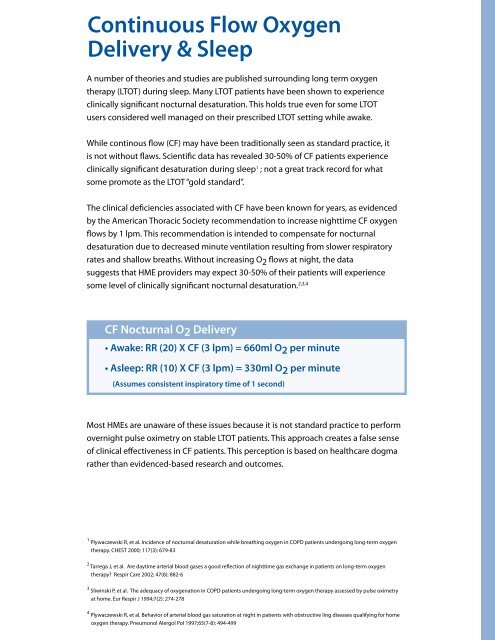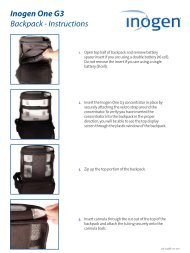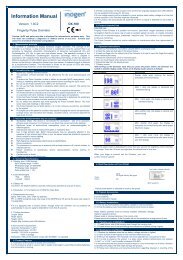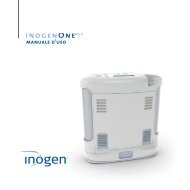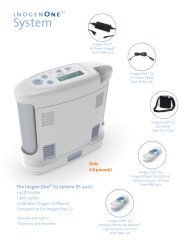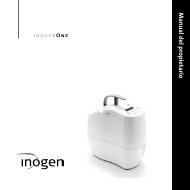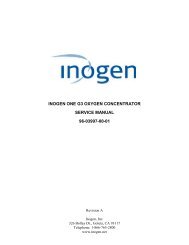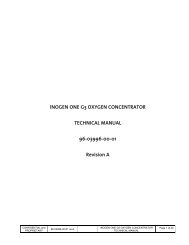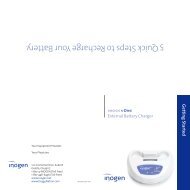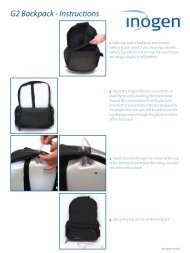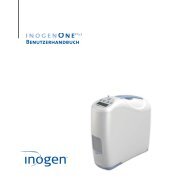Up to 50% of continuous flow oxygen therapy patients ... - Inogen One
Up to 50% of continuous flow oxygen therapy patients ... - Inogen One
Up to 50% of continuous flow oxygen therapy patients ... - Inogen One
Create successful ePaper yourself
Turn your PDF publications into a flip-book with our unique Google optimized e-Paper software.
Continuous Flow Oxygen<br />
Delivery & Sleep<br />
A number <strong>of</strong> theories and studies are published surrounding long term <strong>oxygen</strong><br />
<strong>therapy</strong> (LTOT) during sleep. Many LTOT <strong>patients</strong> have been shown <strong>to</strong> experience<br />
clinically significant nocturnal desaturation. This holds true even for some LTOT<br />
users considered well managed on their prescribed LTOT setting while awake.<br />
While continous <strong>flow</strong> (CF) may have been traditionally seen as standard practice, it<br />
is not without flaws. Scientific data has revealed 30-<strong>50%</strong> <strong>of</strong> CF <strong>patients</strong> experience<br />
clinically significant desaturation during sleep 1 ; not a great track record for what<br />
some promote as the LTOT “gold standard”.<br />
The clinical deficiencies associated with CF have been known for years, as evidenced<br />
by the American Thoracic Society recommendation <strong>to</strong> increase nighttime CF <strong>oxygen</strong><br />
<strong>flow</strong>s by 1 lpm. This recommendation is intended <strong>to</strong> compensate for nocturnal<br />
desaturation due <strong>to</strong> decreased minute ventilation resulting from slower respira<strong>to</strong>ry<br />
rates and shallow breaths. Without increasing O 2 <strong>flow</strong>s at night, the data<br />
suggests that HME providers may expect 30-<strong>50%</strong> <strong>of</strong> their <strong>patients</strong> will experience<br />
some level <strong>of</strong> clinically significant nocturnal desaturation. 2,3,4<br />
CF Nocturnal O2 Delivery<br />
• Awake: RR (20) X CF (3 lpm) = 660ml O2 per minute<br />
• Asleep: RR (10) X CF (3 lpm) = 330ml O2 per minute<br />
(Assumes consistent inspira<strong>to</strong>ry time <strong>of</strong> 1 second)<br />
Most HMEs are unaware <strong>of</strong> these issues because it is not standard practice <strong>to</strong> perform<br />
overnight pulse oximetry on stable LTOT <strong>patients</strong>. This approach creates a false sense<br />
<strong>of</strong> clinical effectiveness in CF <strong>patients</strong>. This perception is based on healthcare dogma<br />
rather than evidenced-based research and outcomes.<br />
1 Plywaczewski R, et al. Incidence <strong>of</strong> nocturnal desaturation while breathing <strong>oxygen</strong> in COPD <strong>patients</strong> undergoing long-term <strong>oxygen</strong><br />
<strong>therapy</strong>. CHEST 2000; 117(3): 679-83<br />
2 Tarrega J, et al. Are daytime arterial blood gases a good reflection <strong>of</strong> nighttime gas exchange in <strong>patients</strong> on long-term <strong>oxygen</strong><br />
<strong>therapy</strong>? Respir Care 2002; 47(8): 882-6<br />
3 Sliwinski P, et al. The adequacy <strong>of</strong> <strong>oxygen</strong>ation in COPD <strong>patients</strong> undergoing long-term <strong>oxygen</strong> <strong>therapy</strong> assessed by pulse oximetry<br />
at home. Eur Respir J 1994;7(2): 274-278<br />
4 Plywaczewski R, et al. Behavior <strong>of</strong> arterial blood gas saturation at night in <strong>patients</strong> with obstructive ling diseases qualifying for home<br />
<strong>oxygen</strong> <strong>therapy</strong>. Pneumonol Alergol Pol 1997;65(7-8): 494-499


